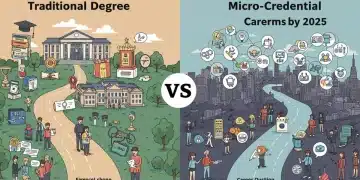Maximizing Education Budgets: 7 Financial Strategies for 2025

School districts across the nation are actively developing new approaches to maximize their financial resources, with a significant push towards innovative strategies for education budgets in 2025.
As school districts prepare for the upcoming fiscal year, the imperative to implement effective financial management has never been more critical. The landscape of educational funding is constantly evolving, requiring proactive and strategic approaches. This article explores Maximizing Education Budgets: 7 Financial Impact Strategies for School Districts in 2025, offering insights into how to navigate these challenges and ensure sustained academic success.
Strategic Resource Allocation and Prioritization
Effective resource allocation is foundational to maximizing education budgets. School districts must move beyond traditional budgeting methods to embrace a more strategic approach that directly links spending to educational outcomes. This involves a thorough analysis of current expenditures and their impact on student achievement and operational efficiency.
A recent report from the Council of the Great City Schools emphasizes that districts achieving significant improvements often share a common trait: a clear and data-driven approach to resource allocation. This means identifying underperforming programs and reallocating funds to initiatives that demonstrate proven results. Prioritization is key, especially when faced with limited resources and competing demands.
Data-Driven Spending Decisions
Utilizing robust data analytics platforms can provide district leaders with the necessary insights to make informed decisions. This includes tracking student performance metrics, program effectiveness, and cost-benefit analyses of various initiatives. The goal is to ensure every dollar spent contributes positively to the district’s educational mission.
- Identify high-impact programs through performance data.
- Evaluate cost-effectiveness of current educational technologies.
- Reallocate funds from inefficient programs to proven strategies.
- Engage stakeholders in budget review processes for transparency.
Leveraging Technology for Operational Efficiency
Technology offers significant opportunities for school districts to streamline operations and reduce costs. From administrative tasks to classroom management, digital solutions can enhance efficiency, freeing up resources that can then be redirected to core educational programs. This strategy is becoming increasingly vital for education budgets in 2025.
Many districts are now exploring AI-powered tools for scheduling, transportation optimization, and even facility management. The initial investment in these technologies can yield substantial long-term savings, improving overall operational financial health. As reported by EdTech Magazine, early adopters are seeing significant reductions in administrative overhead.
Automating Administrative Processes
Automation of routine administrative tasks, such as payroll, human resources, and procurement, can drastically reduce the need for manual labor and minimize errors. This not only saves money but also allows staff to focus on more complex and impactful work, directly benefiting students and teachers.
Cloud-based solutions, in particular, offer scalability and reduced infrastructure costs, making them an attractive option for districts of all sizes. These systems can also improve data security and accessibility, crucial aspects in today’s digital environment.
Optimizing Procurement and Supply Chain Management
Procurement is often one of the largest expenditure categories for school districts. Implementing optimized procurement and supply chain management strategies can lead to significant savings. This involves strategic sourcing, bulk purchasing, and negotiating favorable contracts with vendors.
Districts are increasingly forming purchasing cooperatives to leverage collective buying power, securing better pricing on everything from textbooks to cafeteria supplies. Transparency in the procurement process is also crucial, ensuring fair competition and preventing potential waste or fraud, which directly impacts the ability for maximizing education budgets.
Strategic Vendor Relationships
Building strong, long-term relationships with key vendors can lead to more favorable terms and better service. This goes beyond simply choosing the lowest bidder and involves evaluating vendor reliability, quality of goods, and responsiveness to district needs.
- Implement e-procurement platforms for increased transparency.
- Participate in regional or national purchasing cooperatives.
- Negotiate multi-year contracts for stable pricing.
- Conduct regular audits of vendor performance and pricing.

Enhancing Grant Writing and Fundraising Capabilities
External funding sources, such as grants from federal, state, and private foundations, represent a vital component of a diversified budget strategy. Strengthening a district’s grant writing capabilities can unlock significant additional resources, especially for specialized programs or initiatives that might otherwise go unfunded.
Many districts are now investing in dedicated grant writers or professional development for existing staff to improve their success rates. Furthermore, engaging the community through local fundraising efforts can provide valuable supplementary funds and foster greater community involvement in schools, a key aspect of maximizing education budgets.
Targeted Grant Applications
Identifying grants that align perfectly with district goals and needs is paramount. This requires careful research and a clear understanding of the grant-making organization’s priorities. A well-crafted grant proposal, demonstrating clear objectives and measurable outcomes, significantly increases the chances of success.
Building relationships with foundation program officers and attending grant-seeking workshops can also provide valuable insights and networking opportunities. These efforts contribute to a more robust financial outlook for the district.
Personnel Cost Management and Staffing Optimization
Personnel costs typically constitute the largest portion of a school district’s budget. Effective management of these costs, without compromising educational quality, is a delicate but essential task. This involves strategic staffing, professional development investments, and exploring innovative compensation models.
Districts are increasingly analyzing class sizes, student-to-teacher ratios, and administrative overhead to identify areas for optimization. Investing in high-quality professional development can also reduce turnover, a significant hidden cost for many districts, directly impacting the fiscal health for education budgets in 2025.
Strategic Staffing Models
Exploring flexible staffing models, such as shared positions across schools or leveraging part-time specialists, can help manage costs while still providing essential services. Data-driven enrollment projections are also crucial for accurately anticipating staffing needs and avoiding unnecessary hires.
- Analyze and optimize student-to-teacher ratios.
- Invest in professional development to reduce staff turnover.
- Review benefits packages for cost-effectiveness and competitiveness.
- Implement performance-based compensation where appropriate.
Energy Efficiency and Facilities Management
Operational costs related to facilities, particularly energy consumption, can be substantial. Implementing energy-efficient technologies and proactive facilities management practices can lead to considerable long-term savings. This includes upgrading to LED lighting, optimizing HVAC systems, and investing in renewable energy sources where feasible.
Many districts are finding that green initiatives not only save money but also align with community values and provide educational opportunities for students on sustainability. The Department of Energy has highlighted several school districts that have achieved millions in savings through comprehensive energy management programs, directly contributing to maximizing education budgets.
Sustainable Infrastructure Investments
Long-term planning for facility maintenance and upgrades can prevent costly emergency repairs. Investing in durable, energy-efficient infrastructure from the outset can provide significant returns over the lifespan of the buildings. This proactive approach ensures facilities remain safe, functional, and cost-effective.
Engaging facility managers in budget planning is vital to identify potential savings and areas for improvement. Their expertise is invaluable in developing realistic and impactful sustainability strategies.
Community Partnerships and Shared Services
Forging strong partnerships with local businesses, non-profit organizations, and other government entities can unlock new resources and create efficiencies. Shared services agreements, for instance, can reduce costs for transportation, food services, or specialized instructional programs by pooling resources with neighboring districts or municipalities.
Community partnerships can also provide volunteers, internship opportunities for students, and in-kind donations, all of which supplement district resources without direct financial outlay. These collaborations enhance the educational experience while simultaneously supporting the district’s financial health, a core strategy for maximizing education budgets.
Collaborative Resource Sharing
Exploring inter-district agreements for specialized services, such as psychological support or advanced vocational training, can ensure students receive necessary resources without each district bearing the full cost independently. This collaborative model is gaining traction as districts seek innovative ways to stretch their budgets further.
Establishing a clear framework for these partnerships, including formal agreements and communication protocols, ensures their success and sustainability. These initiatives reflect a growing trend towards regional cooperation in education.
| Key Strategy | Brief Description |
|---|---|
| Strategic Allocation | Data-driven allocation linking spending to educational outcomes. |
| Tech Efficiency | Leveraging technology to automate tasks and streamline operations. |
| Grant Funding | Enhancing grant writing and fundraising to secure external funds. |
| Community Partnerships | Collaborating with local entities for shared services and resources. |
Frequently Asked Questions About Education Budgets
The primary goal is to ensure financial sustainability for school districts while directly improving student outcomes and educational quality. This involves optimizing resource allocation to support effective teaching and learning environments.
Technology can streamline administrative tasks, enhance communication, and improve resource management. Automation reduces manual labor and errors, freeing up funds and personnel for core educational activities, ultimately boosting efficiency.
Community partnerships provide access to additional resources, volunteers, and shared services, reducing direct financial outlays. They foster collaboration, enhance student opportunities, and bolster overall district support, stretching budget impact.
Data provides crucial insights into program effectiveness and expenditure impact. It enables districts to make informed decisions, reallocate funds from underperforming areas, and prioritize initiatives that yield measurable positive results for students.
Effective management includes strategic staffing models, investing in professional development to reduce turnover, and reviewing benefits packages. The goal is to optimize staffing without compromising the quality of education or teacher morale.
What Happens Next
As school districts continue to navigate complex financial landscapes, the implementation of these strategies for maximizing education budgets in 2025 will be closely monitored. The focus remains on sustainable financial practices that directly enhance student learning and operational efficiency. Expect to see continued innovation in technology integration, collaborative partnerships, and data-driven decision-making as districts strive to adapt to evolving educational and economic demands. The coming months will be critical for solidifying these plans and preparing for the next fiscal cycle.





